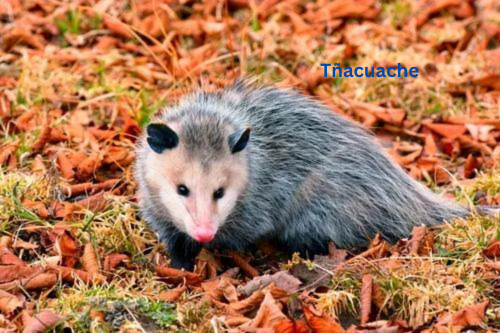It is also known as the opossum, is a fascinating marsupial that has long been misunderstood by humans. While often regarded as a nuisance, it plays an integral role in maintaining ecosystem balance. This article delves into the ecological importance of the tñacuache, highlighting how this marsupial contributes to biodiversity, pest control, nutrient cycling, and habitat maintenance.
As the only marsupial species native to North America, it has evolved remarkable adaptations that allow it to survive in diverse environments. Despite its resilience, habitat loss and human activity continue to pose threats to its populations. By gaining a deeper understanding of its ecological roles, we can foster a better appreciation for this unique animal and the critical contributions it makes to our ecosystems.
What is a Tñacuache?
The it or opossum, is a member of the Didelphidae family of marsupials. In North America, it is commonly referred to as the Virginia opossum (Didelphis virginiana), but it can also be found in Central and South America, where several different species exist. The most distinctive characteristic of marsupials like this is their reproductive process. Females give birth to underdeveloped young that complete their development in a pouch, where they are nurtured and protected.
It has a long snout, sharp teeth, a pointed face, and a prehensile tail that it uses for balance and climbing. Its coarse fur is typically gray or brown, and it has a distinctive white face with black eyes and ears. Despite its rather intimidating appearance, it is non-aggressive and generally avoids confrontation with humans and other animals.
They are nocturnal creatures, meaning they are most active during the night. They are opportunistic omnivores, with a diet that includes fruits, vegetables, insects, small animals, and carrion. Their ability to consume a wide variety of foods makes them highly adaptable to changing environments, from dense forests to urban areas. Although often seen scavenging in garbage cans, its foraging habits play an important role in pest control and nutrient cycling, as we will explore further.
Ecological Importance of Tñacuaches
Natural Pest Control
One of the most beneficial roles it plays in ecosystems is controlling populations of pests. They are voracious eaters of insects, particularly ticks, beetles, cockroaches, slugs, and other invertebrates that can wreak havoc on plants and agriculture. By feeding on these pests, it reduces their numbers, which helps protect crops, gardens, and even human health.
Ticks, in particular, pose a significant threat to both wildlife and humans, as they are carriers of Lyme disease and other harmful pathogens. Research has shown that a single tick can consume thousands of ticks in a single season, helping to mitigate the spread of tick-borne illnesses. Their ability to consume large quantities of ticks, even in suburban areas, makes them one of nature’s best defenses against the proliferation of these dangerous pests.
In addition to insects,it also eats small rodents, such as mice and rats. These rodents are not only pests but can also spread diseases like hantavirus and leptospirosis. It helps keep rodent populations in check, preventing infestations in both natural and urban environments. This natural form of pest control reduces the need for chemical pesticides, which can be harmful to other wildlife and ecosystems.
Scavengers and Decomposers
Another key role it plays in ecosystems is that of scavengers and decomposers. As opportunistic feeders,it will consume carrion—dead animals that other predators have left behind. This behavior is crucial for maintaining healthy ecosystems, as it aids in the decomposition process and helps recycle nutrients back into the soil.
Scavengers like it play a vital role in cleaning up ecosystems by removing dead animals that could otherwise become sources of disease and infection. In doing so, they contribute to the natural breakdown of organic matter, ensuring that essential nutrients are returned to the environment for plants and other organisms to use. Without scavengers like it, dead animals would linger and decay slowly, attracting flies and other pests while potentially spreading disease.
In urban areas, it performs a similar function by scavenging for food scraps and waste left by humans. While this behavior may be viewed as a nuisance, it actually serves an important purpose by reducing the amount of waste in the environment and helping to prevent the spread of diseases associated with decaying organic matter.
Seed Dispersal of Tñacuache
Although they are primarily known for their pest control and scavenging behaviors, it also plays an indirect but important role in seed dispersal. Many fruits and berries are part of the diet, and as they consume these foods, they also ingest the seeds. The seeds then pass through their digestive system and are excret in new locations, where they can germinate and grow.
This process of seed dispersal helps maintain plant diversity and promotes the regeneration of forests and other habitats. By dispersing seeds, it contributes to the propagation of plant species, ensuring that different types of vegetation continue to thrive in their ecosystems. In areas where human activity has disrupted natural seed dispersal mechanisms, animals like it help restore balance by spreading seeds across the landscape.
Prey for Predators of Tñacuache
It is also an essential part of the food web, serving as prey for a variety of predators, including owls, hawks, foxes, coyotes, and larger mammals like bobcats. As a prey species, it helps sustain predator populations, ensuring that these predators have a consistent food source to maintain their own numbers. The presence of predators is critical for maintaining balance within ecosystems, as they regulate populations of other species, preventing any one species from becoming too dominant.
By providing sustenance for predators,it helps maintain the delicate predator-prey relationships that are vital to the health of ecosystems. Without enough prey species like it , predator populations would decline, leading to an imbalance that could affect other species further down the food chain.
Also Read: puppy:1azdln0ha3y= Golden
Tñacuache Adaptations and Survival Strategies
Tñacuaches have several unique adaptations that allow them to thrive in a variety of environments. One of the most well-known is their ability to “play dead,” also known as thanatosis. When threatened by a predator, it may collapse, lying motionless with its mouth open and tongue out, mimicking the appearance of a dead animal. This behavior can last for several minutes or even hours, during which it emits a foul odor to deter predators from approaching. Most predators prefer live prey and will leave the “dead” it alone, allowing it to escape once the threat has passed.
In addition to their impressive defense mechanisms, they are highly adaptable foragers. Their omnivorous diet allows them to eat a wide range of foods, from fruits and insects to small animals and carrion. This dietary flexibility is one of the reasons they have been so successful in adapting to different environments, including urban areas where food sources may be more varied.
It is also equip with a prehensile tail, which they use for balance and grasping objects while climbing. This tail, along with their sharp claws, allows them to navigate trees and other vertical structures with ease. In urban areas, they often use their climbing abilities to find shelter in attics, garages, or sheds, where they can avoid predators and harsh weather conditions.
Another remarkable adaptation of it is their immune system. They have a natural resistance to several diseases, including rabies, which is relatively rare among mammals. Their low body temperature makes it difficult for the rabies virus to thrive, which reduces the likelihood of it transmitting the disease to other animals or humans. This resilience contributes to their survival in environments where other species might struggle.
Misconceptions About Tñacuaches
Despite their ecological importance, they are often misunderstood and unfairly maligned by humans. In many cases, people view them as pests or dangerous animals, largely due to misconceptions about their behavior and appearance. However, they are non-aggressive and pose little threat to humans or pets. They are shy creatures that prefer to avoid confrontation, and their habit of playing dead is an indication of their desire to escape rather than fight.
As for the myths that are consider and widespread among the people, it is necessary to state that they are not dangerous animals and they do not carry rabies as often as people think. As it has already been said, they do not get rabies easily and are therefore a lot less likely to spread or even harbor the virus than a raccoon or a bat. Indeed, cases of it having rabies are very rare.
Others refer to it as filthy creatures or sickening carriers of diseases since they always scavenge in the litter. Although they do look for foods through picking they do this in a bid to meet their needs without necessarily getting infect by a disease. They are omnivores, which means that they feed on anything that comes their way and, more so in urban human waste, is easily available to them. Contrary to this, it plays a role in the conservation of the hygiene of our urban setting by consuming wastes and eradicating pests.
Tñacuache and Human Interaction
Due to the advancement of human activities that keeps on expanding its civilization and development over the natural environment, it is hence coming closer and closer to the people. This can cause some problems especially when the tñacuaches decide to laze around in attics, basements or sheds. Not all people behave politely toward it, despite it being beneficial to ecosystems, even well-developed ones.
It can therefore be seen that, in most instances, some measures can be taken with the aim of preventing it from moving into human domains without harming them. For instance, using tight-fitting lids on trash receptacles, replacing available food sources like pet foods and bird seeds and plugging accesses to attics and garages will deter it from taking up residence in homes. Capture and or removal: In the event where it is found entering or trap inside pre-harvest buildings or residences, wildlife removal officers can easily trap and or capture the animal for relocation without posing danger to the lives of people in that area.
One must also add that they are not dangerous to pets as well. Although this is true, one cannot deny the fact that it may be dangerous to household pets. They are docile and will not attack bigger animals such as the dogs or cats for instance. Indeed, their presence in backyards is advantageous since the hedgehogs act as natural pest control since they feed on items such as ticks, insects, and rodents.
Conservation Status and Threats
Despite the fact that there is no information mentioning that they are endanger, they are in danger by several factors; these include loss of their habitats, road kills and persecution by human beings. Whereas land is convert for agricultural use, urbanization, and construction, it struggles to find the habitats in which they find food, mate, and conceal themselves.
Another is road traffic since they are easily kill by cars as they cross the roads to look for food or mates. Measures to mitigate road kill for species also involve the putting up of wildlife bridges or underpasses, to help species such as it cross automobile-accessed roads safely.
People’s attitudes towards it or its utilization are also credit for its conservation. This gives room for the negative perceptions to develop hence resulting in unnecessary killing or harm with regard to these animals. Ethical regard and awareness raising educational campaigns aimed at the special roles that it plays in ecosystems should change such attitudes in such a way that people should learn to live with it rather than fighting them.
Conclusion
The tñacuache is a special case of an unusual marsupial that occupies quite a significant niche in the local ecosystems, yet people do not pay enough attention to it. It also has importance in affecting the food chain and ecological balance of the habitats these animals live in by assisting in pest control, feeding on wastes, seed dispersal and providing food to other carnivorous animals. All that coupled by their ability to survive in different environments ranging from urban environments makes them even more valuable.
Therefore, the understanding of ecological functions of it, as well as identification of threats that it is expose to, enables it to protect these animals and maintain them as a part of our ecosystems. It is easy to appreciate the beauty of zooming around our backyards or the wild, it also makes us realize that each species is vital in the ecosystem and in the sustainability of the earth.










